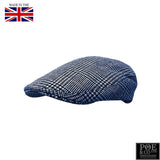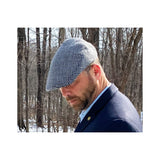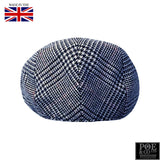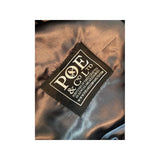Our Garrison is a traditional Flat Cap with a deep back and crown leading to a focused hand-sewn peak finished in a traditional style hessian interlining. This cap boasts a handsome, sleek profile that leaves the wearer looking a bit more "dapper" with it on. Whether you need to take care of the day's business or are going out for a night on the town, The Garrison emanates class and style.
We selected to bring The Prince of Wales check tweed to you for so many reasons! First and foremost, 100% British Wool. Second... How smooth and generally lightweight! If you closed your eyes and ran your hand across the bridge, we guarantee you would think it was a cool, smooth cashmere!
And last? The HISTORY!
It was first popularized in the late 19th Century by the Prince of Wales “Bertie”, the future Edward VII, and anew in the 1920s by his grandson David, who would be the Duke of Windsor. The Prince of Wales design is an adapted version of Glenurquhart Checks from Seafield Estate.
It is likely you have heard of “Prince of Wales” check in one form or another. It is known under many different guises; Glen Check, Glen Plaid, Glen Urquhart Plaid and many more. It is worn far and wide by members of state and celebrities alike, but let’s see how it came about.
The Scottish Register of Tartan records Prince of Wales Check as actually named “Glenurquhart Estate Check”, registered on the First of January, 1840. The registered and most widely accepted original designer, Miss Elizabeth MacDougall, was a native of the village of Lewston found at the foot of the glen. Miss MacDougall’s design incorporates varying sizes of puppy tooth patterns giving the look of squares and stripes. It is worth noting at this point that some believe that the Countess Caroline of Seafield was instead the original designer of the check. As an accomplished weaver, she would have been easily capable, but it is far more widely accepted that MacDougall, in fact, designed it.
The pattern first came to prominence when Countess Caroline of Seafield herself was looking for something to dress her grounds staff. She was looking for something smart, warm and durable as the weather was often fierce and the clothing needed to be able to withstand all that the Urquhart estate could throw at it. It was when she saw the new check design worn by the local men she found something she could use. Usually, Glen Check is worn in winter and as such is made from thick wool or flannel. This made it an ideal material for the harsh Scottish winter and outdoors. The Countess adopted the material with haste and outfitted her groundsmen with smart suits made of local wool, woven into the newly branded Glenurquhart Estate Check. Over time, the Countess had the design altered with thin coloured stripes (usually green to match the local scenery) added to the tight puppy tooth stripes to make the check as we know it today.
For a while, the check remained a local fashion and was worn mainly by those who worked on the estate. It wasn’t until the then-Prince of Wales, King Edward VII, visited the estate on a hunting trip and observed the estate’s staff wearing the pattern. He liked the design and wore it so much that it garnered the nickname “Prince of Wales Check”.

As with most royal trends, the glen check became one of the most popular designs in the country and was worn very widely. Edward, known as Europe’s Uncle, was famed for his appetite for food, tobacco, and fashion. He was often reprimanded for spending too much time with his tailor - even spending even more with his tailor than he did with his cabinet! So it is no surprise therefore that his taste in clothing was contagious.
In the years to come Edward’s own grandson would adopt the check as his own, rekindling the “Prince of Wales Check” title.

Later Fashion
The Glen Check design stuck around for the years to come, especially in Britain and survived the Second World War with its other Tartan Brethren, but initially didn’t quite take hold as it had in the past. It wasn’t really until the late 40s and early 50s that glen check properly returned. The county gentlemen returning victorious from the war kitted themselves out in Prince of Wales jackets and suits when hunting and partaking in leisurely pursuits.
This carried on into the swinging 60s, where film stars and musicians such as James Bond and the Beatles. Sean Connery’s 3 pieces showed the excellent class and sophistication the material deserved and showed it was far from outdated. Even JFK was seen wearing it, abandoning the American fit 3 button suit and instead, donning a two button European style two button suit instead. The Check made a definite comeback in the 60s and has been highly popular ever since.
From the Highlands of Scotland in the 1800s to the highest office in the world in the 1960s The Glen Check has certainly done the rounds since the King first laid eyes upon it. Hopefully, it will be around for years to come, and will still be as popular as it is today!
[SOME IMAGES COURTESY OF POE & CO® CUSTOMERS WITH PERMISSION FROM SUBJECTS.]

We want you to be proud of the look, style and fit of your Poe & Company Flat Cap or Apparel Item. Below are our sizing charts for you to review before making your purchase. You can also find sizing charts on the independent product pages as you browse the images or descriptions.
We also have a robust return or exchange policy in the event it isn't the exact fit you were looking for. You can visit the Return or Exchange Policy here: Returns & Exchanges
QUICK LINK:
Flat Caps Sizing
Poe and Company Flat Caps have their origins in Great Britain. We are proud to offer them by the centimeter in order to give our customers the closest to a custom fit available in a standard size. Many companies will only offer standard Small - XXX-Large. In doing so, they are able to limit their stock and manufacturing costs passing the off-sizes off to the customer. We want you to love the fit!
For Poe & Company Limited Brand Flat Caps, Use the Chart Below.
We also offer "Harris Tweed Flat Caps from our Friends at Glencroft." You can note a Glencroft Harris Tweed in the Flat Cap descriptions. They generally run 1cm smaller so if you measure as a 59 cm by measuring tape, please order a 58 cm Harris Tweed.
Ladies and Childrens Flat Caps are one-size fits all. Both have an elastic back to accommodate ladies hair styles and growing children.
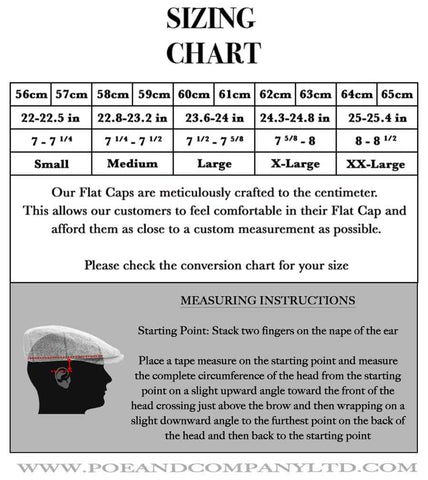
Find your size and find your style. Questions? Email us at: Customer Service
Poe & Company Apparel Sizing
We offer a finely selected range of adult and childrens apparel items. Please review sizing below. You can also find sizing on the independent product pages as you browse the images or descriptions.
| XS | S | M | L | XL | XXL | |
|---|---|---|---|---|---|---|
| Chest | 36-38 | 38-40 | 40-42 | 42-44 | 44-46 | 46-48 |
| Sleeve Length (under arm) | 54 | 55 | 56 | 57 | 57 | 58 |
|
Back Length |
68 | 68 | 68 | 69 | 69 | 69 |


0-3 Months 3-7 Months 7-12 Months
| XS | S | M | L | XL | XXL | |
|---|---|---|---|---|---|---|
| Chest (Inches) | 35-37 | 37-40 | 40-42 | 42-44 | 44-46 | 46-48 |
| Chest (CM) | 87-94 | 94-101 | 101-106 | 106-111 | 111-116 | 116-121 |
| Length (Inches) | 25.5 | 26 | 27 | 28 | 29 | 30 |
| Length (CM) | 65 | 66 | 68.5 | 71 | 73.5 | 76 |
| Sleeve (Inches) | 19 | 19 | 20 | 21 | 22 | 23 |
| Sleeve (CM) | 48 | 48 | 51 | 53 | 56 | 58.5 |
| Arm hole (Inches) | 8 | 8.5 | 9 | 9.5 | 10 | 10 |
| Arm hole (CM) | 20 | 22 | 23 | 24 | 25 | 26 |
 My Account
My Account









